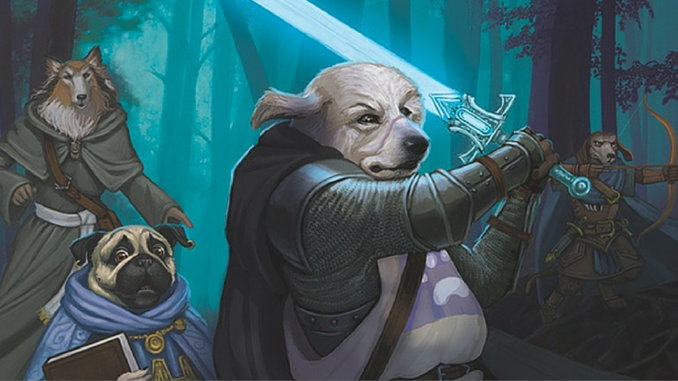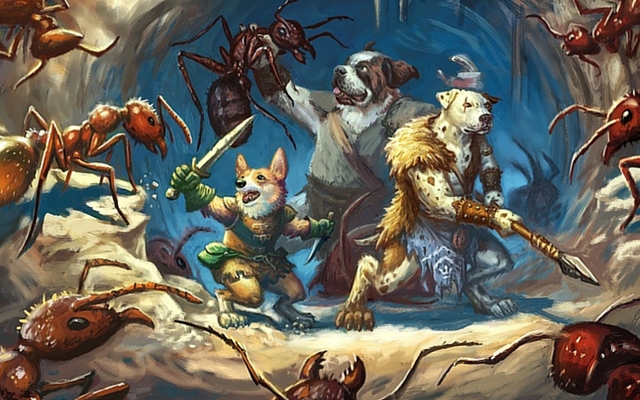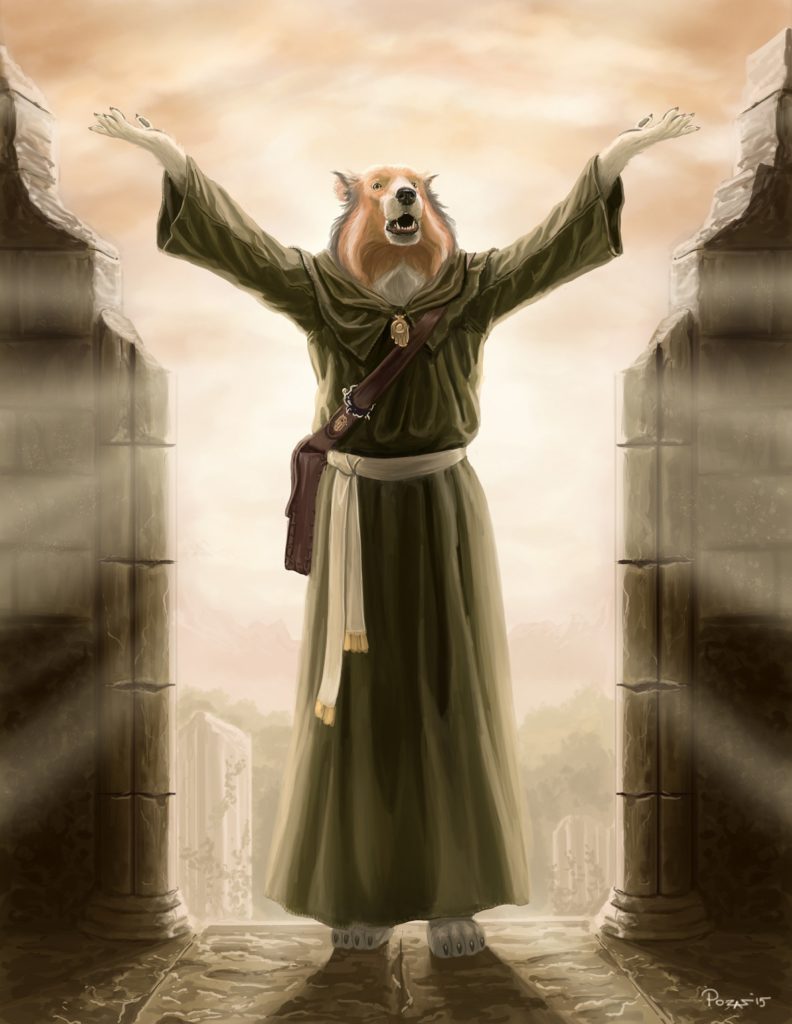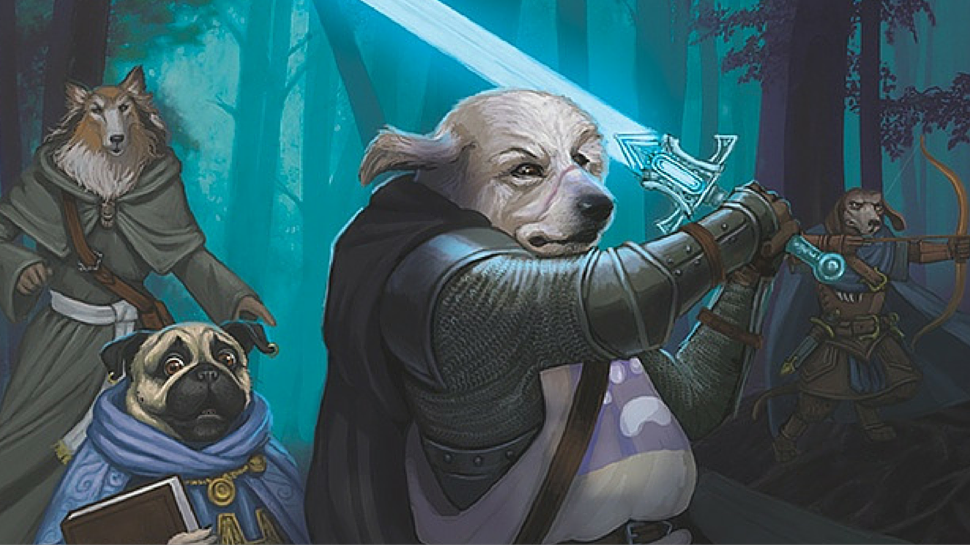
It’s always a treat to finally get the physical rewards for a game that you helped to Kickstart and start paging through the material. I got to experience this again this last week when I got my copy of Pugmire from Eddy Webb and Onyx Path Publishing. I remember first seeing the Kickstarter go live and knew that I needed to get in on it as soon as possible. It promised to be a play experience unlike anything I had previously had. It uses the OGL for 5th Edition Dungeons and Dragons providing a slightly simplified and streamlined version of the rules to provide a light-hearted and family friendly game that allows you to take your dog from 1st level all the way to 10th level as you journey through the lands of Pugmire uncovering secrets of the past.
Wait, why are you looking at me like that?
Yes, I said your dogs. That’s what you play as. Stay with me.

Imagine if you will our world but in the very distant future. Humanity has disappeared for some reason. Maybe they were killed off by extant threat. Maybe they left Earth for the stars. Maybe they simply vanished or evolved into beings of pure energy through reaching some technological or biological breakthrough. The reason is left vague on purpose because that’s not the point – they’re gone, and the world has quite literally gone to the dogs.
In the final years of humanities existence, they began to experiment with genetic manipulation of various animal lifeforms like dogs, granting them greater intelligence and “uplifting” them. A police K-9 was worth more to the force if it could offer testimony in the courtroom. The ability to have a conversation with a seeing eye dog or some other form of companion animal was very desirable on the consumer side. More and more animals underwent the same process after the initial success with dogs, leading to cats, lizards, rats and mice, and other companion creatures getting the same treatment. Over the intervening years, they have evolved past our initial experiments on them and developed their own society that looks similar to medieval life, accented by discoveries of ancient technology such as plastic and other inventions of humanity that help them to survive and thrive in this brave new world. They developed settlements of their own which over time grew into cities which them evolved into the Kingdom of Pugmire where all kinds of dogs gather and live together while they work to explore and discover the past.

They have taken to worshiping Man or “the Old Ones” as gods, believing this world full of magnificent and exciting discoveries were part of the legacy left by their now departed creators. An entire religion has sprung up around this idea, and a Code that most dogs strive to follow is a big part of their basic existence. It’s not exactly religious law, but most dogs place some measure of importance in it – the top of this list is to “be a good dog,” knowing that it was important to the Old Ones in some manner. All other tenets such as “obey the master” and “bite only when endangered” flow from this first one.
But as wonderful and exciting as this world is, it is also dangerous. Interaction with other ancient technologies along with centuries of evolution has caused other animal species to gain sentience. Other monstrous creatures have also been created through mysterious circumstances and interactions with Man’s ancient technology. The cats that live in their own kingdoms to the east are a long-standing threat as well. In fact, the world is still recovering from a long war between the dogs and cats. While they are nominally at peace, tensions are still heavily strained between the two species and violence still regularly erupts between them. And then there is the Unseen – demons and other dangerous things that cannot be seen with the naked eye that dogs believed they used to protect their masters from. These creatures can possess good dogs turning into enemies or act more directly, but their goals always result in betrayal, destruction, and murder.
As noted above, the game runs on the 5th Edition Dungeons and Dragons OGL which makes it both approachable and familiar. Eddy does give some additional suggestions for running games set in the Pugmire world including Pathfinder, Fate Core, Savage Worlds, and Apocalypse World if the 5th Edition OGL isn’t your cup of tea. But the way he has presented it makes it work beautifully.

Instead of choosing between 12 to 13 classes you have one of six callings that emulate common class archetypes from other fantasy games – Artisans study and control arcane magic; Guardians are hale and hearty fighters; Hunters are more at home roaming the countryside protecting civilization from monsters than they are living inside city walls; Ratters instead choose to hunt the sometimes less obvious monsters that exist inside the city walls, engaging in stealth and subterfuge; Shepherds let their faith in Man power them; Strays represent the groups of uncivilized dogs that have left the safety of city walls behind them and survive off the land. After choosing your calling you then further define your character by choosing your breed of dog, which modifies your attributes and gives you access to certain breed specific abilities. For simplicities sake, there are seven common types of “Breeds” which encompass a wide variety of dogs. There are Companions like pugs and pomeranians, Fettles like bulldogs and Pyrenees, Herders like corgis and sheepdogs, Pointers like Labradors and bloodhounds, Runners like greyhounds and wolfhounds, Workers like huskies and malamutes, and finally Mutts who have no common bloodline or pedigree. Finally, you decide what your character’s background was – were they a soldier in the army? Were they an acolyte serving within the Church of Man? Or did they grow up in the bad part of town where they were forced to make some moral compromises in order to survive? While you do that, you also develop your characters personality traits, including the ideal they strive to work towards, a relationship bond with another character or organization in the world, and a flaw that they can never quite overcome.
Your selections for Calling, Breed, and Background gives you training in various skills and saving throws, starting equipment, and access to various “tricks” that you can choose from. These tricks represent your class abilities and will be different from dog to dog, even those of the same breed and calling. Each level you gain allows you to learn a new trick or “refine” an existing trick making it more powerful or giving you more options for its use. Artisans and Shepherds can use their tricks to gain access to powerful magical spells and then further refine them to gain access to higher level spells. Hunters and Guardians can learn to hone their fighting style or they can choose any number of other tricks that fit the general theme of their Calling. Breed tricks are more focused abilities that have fewer refinements available to them, if any, but can give a dog powerful abilities nonetheless. The game supports advancement up to level 10, which may seem short when compared with other games that support advancement far beyond that, but I think it works wonderfully here – it captures the feelings that these creatures aren’t as long-lived as humans, elves, or dwarves. It also helps to keep the math from breaking down and keeps the game moving quickly at the table.
The book itself was a bit surprising. It’s about three quarters the size of a regular RPG Core Rulebook, about as big as a trade comic, though it is hard cover. It clocks in at 252 pages, including an index and blank character sheet. It’s a gorgeous book, full color all the way through. The text is large enough to be easy to read without feeling like it’s wasting space being too big, and the layout mimics that of the 5th Edition Dungeons and Dragons books which make it feel familiar. The art is just wonderful. Equal parts evocative and ridiculous, it really helps to capture the feeling of the setting and the world. It includes everything you need to familiarize yourself with the setting and arms you with everything that your players need to create fun and engaging characters, including six pregenerated characters. Small chunks of fiction introduce each new section of the book, and there are constant side bars which further explain various things about the setting or rule suggestions that more experienced groups might consider that are written from the perspective of two established characters within the setting. The writing itself is straightforward and easy to understand, detailing the world and setting in large brush strokes, leaving it to each individual Guide to fill in the details as it suits their stories. More than that, it’s incredibly entertaining, and the book features some incredible pun work and things about dog culture that will resonate with and please dog owners and dog lovers of today.
The book also provides Guides with numerous tools to run a game of Pugmire. The first and most obvious is “The Great Cat Conspiracy” an 18-page introductory 1st level adventure located at the back of the book. It is written to introduce new players with both the mechanics and the setting as well as some of the greater themes of the game – mystery, exploration, and the importance of companionship and the company you keep. It also provides them with a ready to use campaign framework by introducing and detailing the Royal Pioneers, a group of explorers that is dedicated to “seeking out new knowledge and relics for the protection and betterment of the kingdom.” They consider dogs from all walks of life for service – anyone can volunteer. If you are pass the tests, you become a Pioneer, and a de facto citizen of Pugmire. Your past is left behind you. This leads many strays, criminals, or those with other sordid pasts to try to join to get a new lease on life.

All-in-all, I feel that this is a game you don’t want to miss. If nothing else, it represents a very well done use of the OGL for 5th Edition Dungeons and Dragons. It does not appear that it is available to the public yet, but you can grab a PDF copy of the early access rules for $1.99 from Drivethru RPG. Eddy Webb’s personal website Pugsteady and through Onyx Path Publishing should have more information when the full game will be available for purchase. It appears that the physical book will retail for $49.99 when it is released. I have no idea what the PDF might end up costing. Now if you’ll excuse me, I need to go and come up with an adventure title more compelling than “Fetch Quest.”

Ah, so no native rules for “vehicles” then (i.e. sailing ships, chariots) Pity.
Actually, does D&D 5e come with vehicle rules? Previous editions handled it in splat books, so I making an assumption about rule availability.
Nothing overly specific. If you need to make a check to control a vehicle, you roll the ability in question, and the tool proficiency for Land Vehicle or Water Vehicle applies as appropriate.
Vehicles travel in much the same way characters afoot do, with some minor exceptions (ships and other non-muscle-powered vehicles can’t change their pace and have a speed limit based on the design).
My opinion, they’re fine. Normally you either narrate the trip and pick up on the far side where interesting things start happening again (the “Red Line Express” from Indiana Jones), or the travel time actually matters and you have some checks in mind for PCs to make along the way, and in either case more detailed vehicle rules would just get in the way.
Me before reading: Yeah, yeah, D&D with dogs, we get it.
After: Where do I buy iiiiiit?
I wonder if getting linked to a particular fandom will hurt it. Hopefully not if its as well put together as your review suggest. Wonder how hard it would be to create a Tail Concerto/Solatorobo conversion. Some general premises match up (cats vs dogs, high tech human creators disappear), but it’d be going from fantasy to steampunk/sky pirate.
Very doubtful there. And to be fair, the overlap on the Venn diagram between the two communities is pretty large from my experience. Regardless this feels more like Redwall or Mouseguard in its presentation – less “you’re a dog who is an adventurer” and more “you’re an adventurer who happens to be a dog.”
I can’t say I’m overly familiar with Tail Concerto, but it wouldn’t be any harder than simply stripping the setting from the game and plopping it into where you want – no more difficult than stripping Faerun out of a series of Forgotten Realms modules that you want to run in your homebrew setting. You’d definitely have to create some rules for vehicles like airships if you plan on using them for anything more than a narrative device, but everything else should port over very easily.